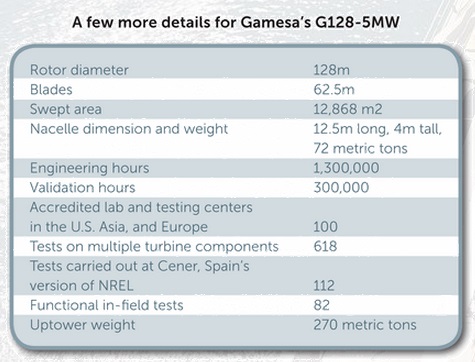
The 62.5m blades are the longest designs produced in Spain. The blades arrive seaside at the turbine site on the Gran Canaria, one of Canary Islands.
Spanish wind-turbine manufacturer Gamesa recently launched an enormous 5 MW turbine on the windy coast of Las Palmas in the Canary Islands, a Spanish territory. Although a somewhat larger version of its 4.5 MW turbine, the company says it boasts several improvements such as modular components and redundant control systems.
The blades, manufactured at a Gamesa plant in Aoiz (Navarre), each span 62.5m and weigh 15 metric tons. They are the largest turbine blades ever produced and transported in Spain and are among the largest ever manufactured in Europe.
The blades are molded in a two-piece (top and bottom) design. This differs from other long Gamesa blades which are molded in separate inboard and tip sections and bolted together at the job site. The turbine has been commissioned and now awaits its type certificate, due about Q1 2014. Serial production of the G128-5.0 MW offshore is planned for 2014.
A few significant component developments include the drive train, called CompacTrain,

At 270 metric tons, the company says 5 MW offshore unit is light enough for a monopole mounting, an advantage in the offshore market where some 5-MW units have been mounted on large and complex four-legged structures. 97% availability is one design goal.
because it combines the main shaft and a two-stage gearbox in a one-piece drive that simplifies alignment. Chief design engineer Fermin Catalan says the design improves reliability by reducing the number of parts and avoids use of high-speed bearings. Preloaded bearings reduce loads, which in turn, reduce mechanical stress and minimize maintenance tasks.
 He pointed to at least three significant developments in the new turbine. First, the drive train has been validated on Gamesa’s 4.5 MW onshore platform. Second, the permanent magnet, synchronous generator sports a full converter. This unit, called GridMate, includes six parallel modules which allow operating it at partial load should an individual module disconnect. Lastly, the company’s control system, MultiSmart, collects operational data to continuously and individually regulate blade pitch to minimize vibration and reduce loads up to 30%.
He pointed to at least three significant developments in the new turbine. First, the drive train has been validated on Gamesa’s 4.5 MW onshore platform. Second, the permanent magnet, synchronous generator sports a full converter. This unit, called GridMate, includes six parallel modules which allow operating it at partial load should an individual module disconnect. Lastly, the company’s control system, MultiSmart, collects operational data to continuously and individually regulate blade pitch to minimize vibration and reduce loads up to 30%.
In late 2012, the company obtained design certification for the offshore turbine from DNV. The certification marked a big step forward in the system’s development because it guarantees the design is in accord with international design norms for offshore turbines.
The first unit, considered a prototype, is installed at the Arinaga quay on a 84-m tower and was unofficially put to work in the summer. The official launch ceremony was held on October 21 for press and dignitaries. Only about three other companies participate in the European offshore wind market. WPE&D
Filed Under: News, Offshore wind, Projects





I’m very proud of this type of projecs